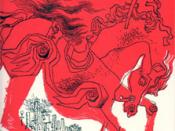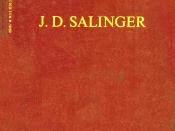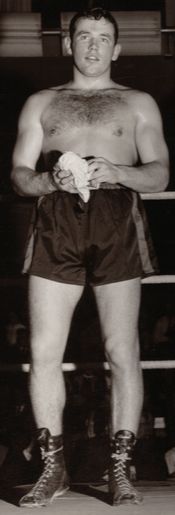How has the concept of ÃÂnew worldsàbeen presented by the director and author whose works you have studied?The concept of ÃÂnew worldsàmanifests in some texts as the process of undertaking transformations to altered levels of understanding, realisation and insight. This concept is presented in many works; two examples being the popular novel The Catcher In The Rye (1951) by J.D. Salinger and Lasse HallströmÃÂs award-winning film My Life As A Dog (1985). The two bildungsroman works share similar structures and thematic concerns but differ in modes of production and context.
The Catcher In The Rye was published when American teenagers began to question and challenge conservative social rules through the onset of pop culture and rock and roll. SalingerÃÂs novel in part questions conformity and became a beacon for disheveled youth. The novel is also influenced by SalingerÃÂs experiences of WWII and boarding schools. The book begins with the protagonist recalling four days of ÃÂmadman stuffÃÂ after expulsion at a boarding school which led to self realization.
The concept of new worlds is presented by the author through context, form, and thematic concerns in The Catcher In The Rye.
My Life As A Dog is a positive, nostalgic view of Sweden in the 1950s from a 1980s perspective. Events referred to in the film are Swedish boxing champion Ingemar Johansson winning a world title, and the race to outer space. Despite this, the movie deals with confronting concerns such as mortality. The film follows IngemarÃÂs transition into adolescence when he is sent off to relatives while his mother ÃÂneeds to restÃÂ from tuberculosis. After his motherÃÂs death and his dogÃÂs death, Ingemar undergoes a short grieving process from which he realizes that ÃÂit could be worseÃÂ and all is not lost. The concept of new worlds is presented by the director through the context, form, and thematic concerns in My Life As A Dog.
The Catcher In The Rye uses authentic teenage idiom written as a stream of consciousness in monologue form to present a new world of understanding. Holden moves by association and this unpredictable narration reflects his personality. Repetition, hyperbole and short sentences are consistent throughout the text such as ÃÂit really didÃÂ and ÃÂit killed meÃÂ. His transition of new emotions is known when he ÃÂmiss[es] everybodyÃÂ when before, he alienates himself as protection. His frequent use of profanity is restrained as coarse language offends him. He envisions himself as the protector of children but later understands that children must take risks and ÃÂgrab for the gold ringÃÂ. Holden sees himself as ÃÂilliterateÃÂ but mentions many texts like ÃÂHamletÃÂ and ÃÂDavid CopperfieldÃÂ with similar stories contradicts his harsh self-dismissal. The novelÃÂs structure begins with Holden recalling four days of wandering in New York. The concept of new worlds is presented by the author through the context, form, and thematic concerns in The Catcher In The Rye.
My Life As A Dog uses cinematic techniques such as aerial shots, music, and different filmstocks to display the new world Ingemar enters. The movie is structured like The Catcher In The Rye begining with Ingemar huddled in his uncleÃÂs summerhouse. He parallels himself to Laika, a spacedog who died from starvation ÃÂfor the benefit of future mankindÃÂ, and the aerial shot shows him in a similar capsule. A slanted aerial shot of a steam train as it travels in summer and winter shows that life goes on, similar to the carrousel in The Catcher In The Rye. The movie uses sparse music unlike typical Hollywood films. Simple piano music and grainy sepia filmstock are used when Ingemar reflects on happy times and near the end, a montage of memories is shown ending with his mother screaming. A close-up shot of IngemarÃÂs smile and a transition of the fireÃÂs glow to water in spring symbolises IngemarÃÂs transition to his new world. Saga also enters a new world when she accepts her gender by wearing a dress rather than pretending to be male. The closing words, ÃÂIngemar didnÃÂt let us downÃÂ, come from the radio when Ingemar Johansson wins the world boxing title for Sweden signalling the end of IngemarÃÂs transition. The concept of new worlds is presented by the director through the context, form, and thematic concerns in My Life As A Dog.
The Catcher In The Rye explores mortality, innocence of children, and conformity. HoldenÃÂs brother Allie dies a premature death from leukaemia and Holden treasures AllieÃÂs baseball mitt, a sign that he has not accepted the death. When questioned to name one thing he likes, James CastleÃÂs suicide at the hands of bullies come to mind. Holden wanted to commit suicide by ÃÂjumping out the windowÃÂ as James Castle did but is held back because he doesnÃÂt want people to look ÃÂat me when I was all goryÃÂ. Holden pictures himself as the ÃÂcatcher in the ryeÃÂ who prevents children from maturing and protector of children who erases all the ÃÂdirtyÃÂ things about life. HoldenÃÂs hate of conformity causes himself to alienate from the ÃÂphoninessÃÂ and ÃÂaffectedÃÂ adult world. He is ÃÂon the other sideÃÂ overlooking ÃÂphoniesÃÂ and wears a red hunting hat, a symbol of his individuality where he ÃÂshoot[s] peopleÃÂ. HoldenÃÂs growth into maturity is brought on by his sister reaching for a gold ring while riding on a carrousel going up and down. The gold ring represents ambitions and the up and down movement symbolises the rollercoaster of life. Holden realises that he cannot stop children from taking risks and everyone must participate in life and have goals. The concept of new worlds is presented by the author through the context, form, and thematic concerns in The Catcher In The Rye.
My Life As A Dog shares thematic concerns with The Catcher In The Rye of mortality and growing up but connects strongly with issues of community. Ingemar suffers the death of the two things he loves most, his mother and dog. He blames himself for his motherÃÂs death and cries ÃÂWhy did you not want me Mama?ÃÂ. As Ingemar passes to the new world of adolescence, he experiences pain, insecurity and dislocation. Separated from his immediate family, he is an outsider in an alien landscape unlike Holden in his familiar town. Ingemar remembers his mother when he ÃÂput[s] things into perspectiveÃÂ and maintains ÃÂa certain distanceÃÂ from worries. His memories are repeated throughout the film and shows his mother as loving and is confused by her erratic screaming. Feelings of community are strong as everyone looks out for each other. Berit acts as a motherly figure as she finds Ingemar and keeps him warm when he runs away. The supportive community provides little time for Ingemar to grieve and gives him a reason to smile and realise that there are good things in life. The concept of new worlds is presented by the director through the context, form, and thematic concerns in My Life As A Dog.
The concept of new worlds has been presented in The Catcher In The Rye by J.D.Salinger and My Life As A Dog by Lasse Hallström through context, form, and thematic concerns. ÃÂNew worldsàis a term used when characters enter a new world of understanding, realisation and insight. The two bildungsroman works share similar structure and thematic concerns but differ in context and modes of production.
Bibliography:"The Catcher In The Rye" (1951) - J.D. Salinger"My Life As A Dog" (1985) - Lasse Hallström





